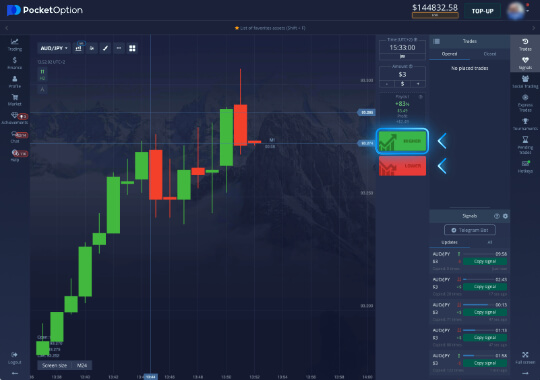
In the world of online trading, platforms like Pocketoption Pocketoption have revolutionized the way traders interact with financial markets. Understanding how to navigate these platforms can significantly impact your success. In this article, we will explore various trading strategies, tips, and the unique features that make Pocketoption a popular choice among traders.
What is Pocketoption?
Pocketoption is a digital trading platform that specializes in binary options trading. Launched in 2017, it aims to provide an intuitive and efficient trading experience for both novice and experienced traders. With a user-friendly interface and a comprehensive set of tools, Pocketoption allows traders to capitalize on price movement across various assets including Forex, stocks, commodities, and cryptocurrencies.
Key Features of Pocketoption
When considering any trading platform, it’s essential to understand its features. Here are some of the most noteworthy aspects of Pocketoption:
- User-Friendly Interface: The platform is designed for ease of use, making it accessible for traders of all levels.
- Wide Range of Assets: Traders can choose from a diverse selection of assets, allowing for flexibility in trading strategies.
- Demo Account: Pocketoption offers a free demo account, which is an excellent way for newcomers to practice trading without risking real money.
- Variety of Trading Options: The platform supports various types of trades, including higher/lower, turbo options, and more, catering to different trading styles.
- Social Trading Features: Users can engage in social trading, allowing them to copy the trades of successful traders and learn from their strategies.
- Responsive Customer Support: Pocketoption provides 24/7 customer support, ensuring help is always available whenever traders encounter issues.
Developing a Trading Strategy
Building a successful trading strategy is crucial for maximizing profits and minimizing risks. Here are some popular strategies that traders often use on Pocketoption:
1. Trend Following

This strategy involves analyzing price movements to identify ongoing trends. Traders using this approach will buy when the price is rising and sell when it starts to fall. Utilizing technical indicators like moving averages can be beneficial in spotting trends.
2. Scalping
Scalping is a technique that focuses on making small profits from minor price changes. Traders will open and close positions quickly, often within minutes. This strategy requires a high level of concentration and a solid understanding of market dynamics.
3. Range Trading
Range trading is based on the idea that prices will often bounce between established support and resistance levels. Traders identify these levels and buy at support while selling at resistance, capitalizing on the predictable price movements.
4. News Trading
News trading revolves around leveraging volatility caused by economic events. Traders need to stay updated with market news and schedules to anticipate price movements following significant announcements.
Risk Management
Even the best trading strategy cannot eliminate all risks, which is why implementing effective risk management practices is essential. Here are a few tips:
- Set a Budget: Determine how much you can afford to lose and stick to that budget.
- Use Stop-Loss Orders: Setting stop-loss orders can limit potential losses on trades.
- Don’t Overleverage: While leverage can amplify profits, it can also magnify losses. Use it cautiously and in moderation.
- Diversify Your Trades: Avoid putting all your capital into one asset. Diversification can help mitigate risks.
Understanding Candlestick Patterns
Candlestick patterns are visual representations of price action that provide valuable insights into market trends. Learning to recognize these patterns can significantly enhance your trading strategy. Here are a few popular patterns:
1. Doji
A doji candlestick indicates indecision in the market. It occurs when the opening and closing prices are virtually the same, suggesting that buyers and sellers are equally matched. This pattern can signal a potential reversal if it occurs after an established trend.
2. Hammer
The hammer pattern occurs after a downtrend and indicates a potential reversal. It has a long lower shadow and a small body, suggesting that buyers are starting to step in.
3. Engulfing Pattern
The engulfing pattern consists of two candles, where the second candle completely engulfs the first. A bullish engulfing pattern occurs after a downtrend, while a bearish engulfing happens after an uptrend, signaling potential reversals.
Utilizing Pocketoption’s Tools
Pocketoption offers various tools aimed at enhancing traders’ experiences. Here are some of the key tools available on the platform:
- Economic Calendar: This tool helps traders keep track of significant economic events and releases that could affect market movements.
- Technical Indicators: Traders can access a wide range of indicators to help analyze market trends and make informed decisions.
- Trading Signals: Pocketoption provides trading signals that can assist traders in executing profitable trades based on market analysis.
Final Thoughts
Pocketoption stands out as a robust trading platform that caters to a wide range of traders. With its user-friendly interface, diverse asset offerings, and valuable trading tools, it provides everything needed for successful online trading. However, success in trading ultimately depends on developing a solid strategy, practicing good risk management, and continuously educating yourself about market trends. By leveraging the features and tools offered by Pocketoption, traders can enhance their trading experience and work towards achieving their financial goals.
发表回复